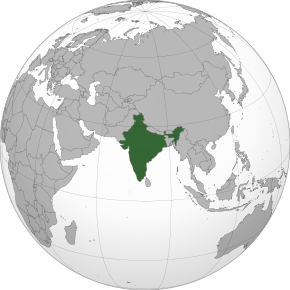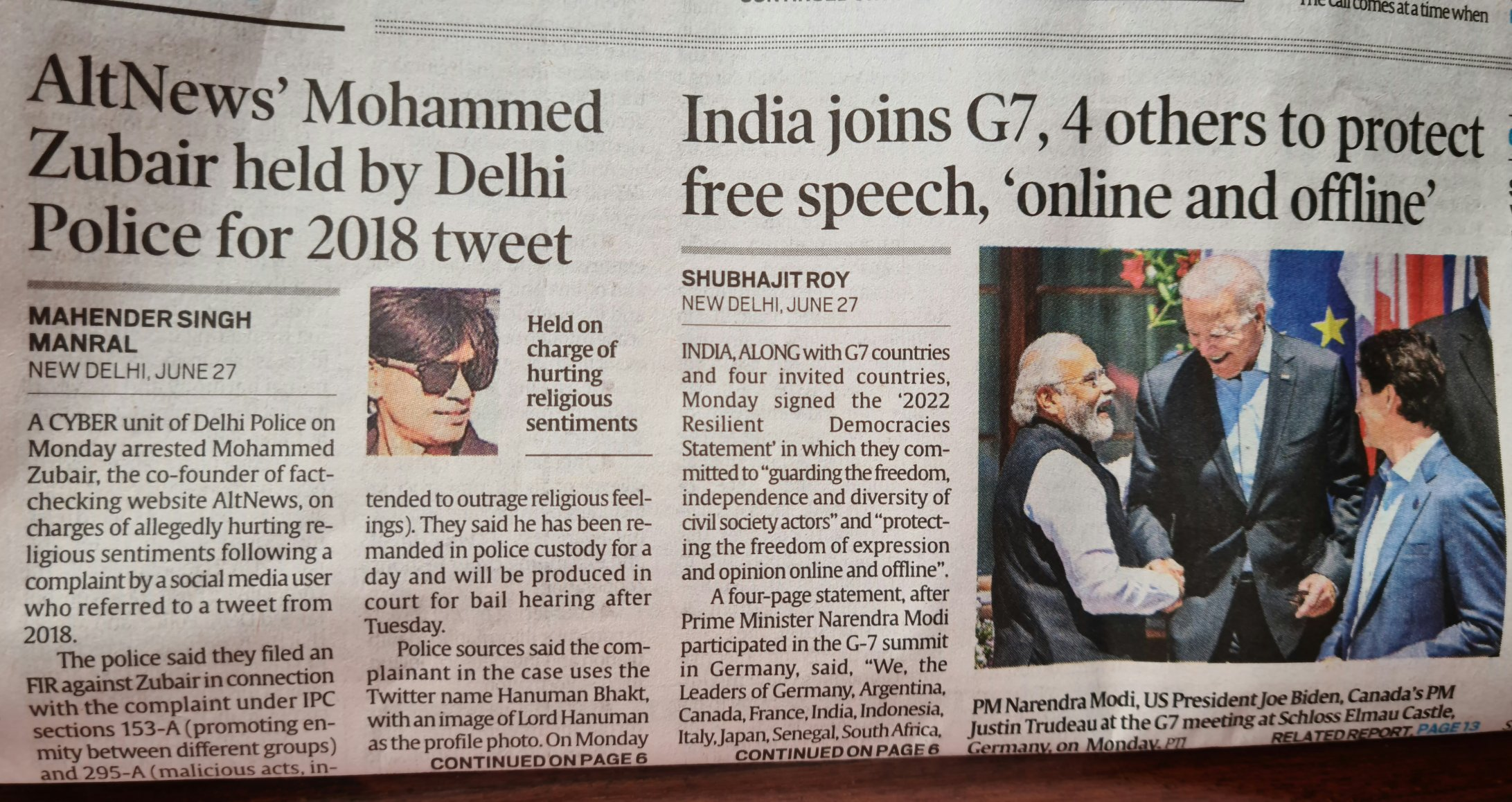More languages
More actions
| Republic of India भारत गणराज्य | |
|---|---|
 | |
| Capital | New Delhi |
| Largest city | Mumbai |
| Official languages | Hindi English |
| Religion | 79.8% Hinduism 14.2% Islam 2.3% Christianity 1.7% Sikhism 0.7% Buddhism 0.4% Jainism 0.23% unaffiliated 0.65% other |
| Dominant mode of production | Capitalism |
| Government | Federal parliamentary bourgeois republic |
• President | Droupadi Murmu |
• Vice President | Jagdeep Dhankar |
• Prime Minister | Narendra Modi |
• Chief Justice | Dhananjaya Y Chandrachud |
| Area | |
• Total | 3,287,263 km² |
| Population | |
• 2018 estimate | 1,352,642,280 |
| Currency | Indian rupee (₹) (INR) |
India, officially the Republic of India, is a bourgeois country in South Asia and the second most-populated country in the world behind the People's Republic of China.[1] Hundreds of languages are spoken in India, and the country has a large Muslim minority that makes up 10% of the world's Muslim population.[2]
History
Bronze Age
An urban civilization developed in the Indus Valley around 2600 BCE. Its major cities included Mohenjo-daro and Harappa. The Indus civilization collapsed around 1900 BCE, and archaeologists found many unburied remains showing signs of violent death.[3]
Iron Age
See main article: Maurya Empire
16 states dominated northern India by 500 BCE, and the Kingdom of Magadha conquered the others by 321 BCE to form the Maurya Empire.[4]
Classical period
See main article: Gupta Empire
Early modern period
See main article: Mughal Empire
Colonization
See main article: British Raj
The British East India Company took control of India in 1765 and established a trade monopoly. The British Raj took control of India in 1847 and suppressed a rebellion in 1857. The British stole at least $44.6 trillion from India, while the population of India dropped by 20% between 1870 and 1920 and tens of millions died from famine under British rule.[5]
Independence movement
In the early 1900s, following the defeat of the Swadeshi movement, Indians began boycotting British goods and picketing their shops. In 1908, the workers of Mumbai went on strike.[6]:34 Following the Jallianwallah Bagh massacre, the Indian National Congress met in 1919 at Amritsar. Nehru wanted to redistribute land to the peasants, but Gandhi prevented the Congress from following that path.[6]:40 In February 1946, strikes took place within the Royal Indian Navy and mutinies within various army units; along with the assistance of 300k workers. British ruling circles soon admitted that the colonial model in India was unsustainable, accepting that the anti-colonialist movement had assumed a mass character.[7]
Independence
Nehru government
Nehru's first two five-year plans, which ended in 1961, failed to lessen inequality.[8] He ousted a Communist government from power in Kerala.[9] India fought against China in 1962 and against Pakistan in 1965.[10]:215
Nehru died in 1964, and Indira Gandhi became prime minister in 1966. She ruled under martial law from 1975 to 1977, when she left office. She returned to power in 1980. The INC lost the 1983 elections in several southern states, with N. T. Rama Rao taking power in Andhra Pradesh and the Janata Party taking power in Karnataka. It won in Assam, where only 2% of the population voted among widespread ethnic violence.[10]:208
In 1989, India introduced economic changes that allowed capitalists to take control of scarce natural resources.[11]
BJP government

Narendra Modi's far-right Bharatiya Janata Party won 303 out of 543 seats in parliament in 2019 and 240 seats in 2024. His National Democratic Alliance won a total of 293 seats, which is enough to form a government and give him another term as Prime Minister.[12]
Demographics
40% of India's 1.4 billion people are under 25 years old. Youth unemployment is 45.4% while overall unemployment is only 7.5%.[12]
References
- ↑ Philip B. Calkins (2022). India. Encyclopedia Britannica.
- ↑ Mike Wang (2014-05-22). "The election of Narendra Modi and the dangerous rise of India’s far-right" Liberation News. Archived from the original on 2019-07-14. Retrieved 2023-02-11.
- ↑ Neil Faulkner (2013). A Marxist History of the World: From Neanderthals to Neoliberals: 'The First Class Societies' (pp. 19–21). [PDF] Pluto Press. ISBN 9781849648639 [LG]
- ↑ Chris Harman (1999). A People's History of the World: 'Iron and empires' (p. 49). [PDF] London: Bookmarks Publications Ltd. ISBN 9781898876557 [LG]
- ↑ Jason Hickelby (2019-01-09). "How Britain Stole $45 Trillion From India And Lied About It" Black Agenda Report. Archived from the original on 2022-01-06. Retrieved 2022-09-08.
- ↑ 6.0 6.1 Vijay Prashad (2017). Red Star over the Third World: 'Follow the Path of the Russians!'. [PDF] New Delhi: LeftWord Books.
- ↑ M. Alexeyev (1948). Indian Union and Pakistan After the Partition of India (pp. 1-2). [PDF] Bolshevik.
- ↑ Vijay Prashad (2008). The Darker Nations: A People's History of the Third World: 'Arusha' (p. 199). [PDF] The New Press. ISBN 9781595583420 [LG]
- ↑ Vijay Prashad (2008). The Darker Nations: A People's History of the Third World: 'Bali' (p. 162). [PDF] The New Press. ISBN 9781595583420 [LG]
- ↑ 10.0 10.1 Vijay Prashad (2008). The Darker Nations: A People's History of the Third World: 'New Delhi'. [PDF] The New Press. ISBN 9781595583420 [LG]
- ↑ "‘India after Naxalbari: Unfinished History’" (2022-07-14). Monthly Review. Retrieved 2022-07-14.
- ↑ 12.0 12.1 Vijay Prashad (2024-06-13). "Democracy Will Not Come through Compromise and Fear: The Twenty-Fourth Newsletter (2024)" The Tricontinental. Archived from the original on 2024-06-13.


